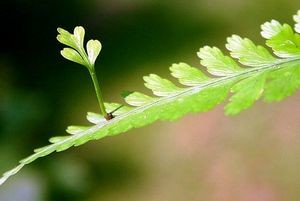 Asplenium bulbiferum. Photo: Tony Foster.Epiphytic vascular plants are a conspicuous component of New Zealand ecosystems. It is unlikely you could go for a walk in New Zealand without seeing one or more of them. Epiphytes have the advantage of greater light but are disadvantaged in that they are prone to dessication and often have a limited supply of soil in which to grow. Epiphytes have therefore evolved modifications that enable them to store water and to reduce its loss by evaporation.
Asplenium bulbiferum. Photo: Tony Foster.Epiphytic vascular plants are a conspicuous component of New Zealand ecosystems. It is unlikely you could go for a walk in New Zealand without seeing one or more of them. Epiphytes have the advantage of greater light but are disadvantaged in that they are prone to dessication and often have a limited supply of soil in which to grow. Epiphytes have therefore evolved modifications that enable them to store water and to reduce its loss by evaporation.
108 native vascular epiphytic plants are identified here and are split into four groups (following Oliver 1930):
A full list of the 108 native vascular plants that have been recorded as epiphytic in New Zealand is provided here:
For more information about epiphytes see:
- The New Zealand Epiphyte Network
- Kirby, K (2014). Field guide to New Zealand’s epiphytes, vines & mistletoes
- Affeld, K. 2008. Spatial complexity and microclimatic responses of epiphyte communities and their invertebrate fauna in the canopy of northern rata (Metrosideros robusta A. Cunn.: Myrtaceae) on the West Coast of the South Island, New Zealand. PhD Thesis, Lincoln University.
- Dawson, J. 1986. The vines, epiphytes and parasites of New Zealand forests. Tuatara: 28 (2).
- Hatch, E. D. 1948: The epiphytic orchids of New Zealand. Trans. Roy. Soc. N.Z. 78: 101-105.
- Hofstede RGM, Dickinson KJM, Mark AF (2001) Distribution, abundance and biomass of epiphyte-lianoid communities in a New Zealand lowland Nothofagus-podocarp temperate rain forest: tropical comparisons. Journal of Biogeography28, 1033-1049.
- Oliver, W. R. B. O. 1930: New Zealand Epiphytes. Journ. Ecol. 18:1-50
- Pope, A. 1924: The role of the tree fern in the New Zealand bush. N.Z. Journ. Sci. Tech. 7: 52-61.
